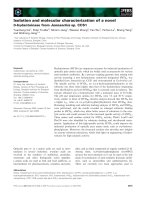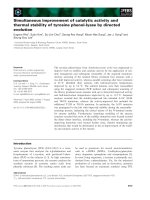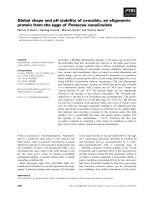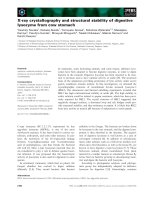EXISTENCE AND GLOBAL STABILITY OF POSITIVE PERIODIC SOLUTIONS OF A DISCRETE PREDATOR-PREY SYSTEM potx
Bạn đang xem bản rút gọn của tài liệu. Xem và tải ngay bản đầy đủ của tài liệu tại đây (564.97 KB, 16 trang )
EXISTENCE AND GLOBAL STABILITY OF POSITIVE
PERIODIC SOLUTIONS OF A DISCRETE
PREDATOR-PREY SYSTEM WITH DELAYS
LIN-LIN WANG, WAN-TONG LI, AND PEI-HAO ZHAO
Received 13 January 2004
We study the existence and global stability of positive periodic solutions of a periodic
discrete predator-prey system with delay and Holling type III functional response. By us-
ing the continuation theorem of coincidence degree theory and the method of Lyapunov
functional, some sufficient conditions are obtained.
1. Introduction
Many realistic problems could be solved on the basis of constructing suitable mathemat-
ical models, but it is obvious that a perfect model cannot be achieved because even if we
could put all possible factors in a model, the model could never predict ecological catas-
trophes or mother nature caprice. Therefore, the best we can do is to look for analyzable
models that describe as well as possible the reality on populations. From a mathematical
point of view, the art of good modelling relies on t he following: (i) a sound understanding
and appreciation of the biological problem; (ii) a realistic mathematical representation of
the important biological phenomena; (iii) finding useful solutions, preferably quantita-
tive; (iv) a biological interpretation of the mathematical results in terms of insights and
predictions.
Usually a mathematical model could be described by two types of systems: a contin-
uous system or a discrete one. When the size of the population is rarely small or t he
population has nonoverlapping generations, we may prefer the discrete models. Among
all the mathematical models, the predator-prey systems play a fundamental and crucial
role (for more details, we refer to [3, 6]). In general, a predator-prey system may have the
form
x
= rx
1 −
x
K
−ϕ(x)y,
y
= y
µϕ(x) −D
,
(1.1)
where ϕ(x) is the functional response function. Massive work has been done on this issue.
We refer to the monographs [4, 10, 18, 20] for general delayed biological systems and to
Copyright © 2004 Hindawi Publishing Corporation
Advances in Difference Equations 2004:4 (2004) 321–336
2000 Mathematics Subject Classification: 34C25, 39A10, 92D25
URL: />322 Existence and stability of periodic solutions
[2, 8, 9, 11, 21, 24] for investigation on predator-prey systems. Here, ϕ(x)maybediffer-
ent response functions: standard ty pe II and type III response functions (Holling [12]),
Ivlev’s functional response (Ivlev [17]), and Rosenzweig functional response (Rosenzweig
[22]). Systems with Holling-type functional response have been investigated by many au-
thors, see, for example, Hsu and Huang [13], Rosenzweig and MacArthur [22, 23]. They
studied the stability of the equilibria, existence of Hopf bifurcation, limit cycles, homo-
clinic loops, and even catastrophe.
On the other hand, in view of the periodic variation of the environment (e.g., food
supplies, mating habits, seasonal affects of weather, etc.), it would b e of interest to study
the global existence and global stability of positive s olutions for periodic systems [18].
Recently, some excellent existence results have been obtained by using the coincidence
degree method (see, e.g., [5, 14, 15, 16, 19, 27]).
Motivated by the above considerations, we will consider the discrete predator-prey
system with Holling type III functional response. The corresponding continuous system
which has been investigated in our previous articles [25, 26] with discrete delays takes the
form
N
1
(t) =N
1
(t)
b
1
(t) −a
1
(t)N
1
t −τ
1
−
α
1
(t)N
2
1
(t)N
2
(t −σ)
1+mN
2
1
(t)
,
N
2
(t) =N
2
(t)
−b
2
(t) −a
2
(t)N
2
(t)+
α
2
(t)N
2
1
t −τ
2
1+mN
2
1
t −τ
2
,
(1.2)
where N
1
(t)andN
2
(t) represent the densities of the prey population and predator popu-
lation at time t, respectively; m, τ
1
, τ
2
,andσ are nonnegative constants; a
1
(t), b
1
(t), α
1
(t),
a
2
(t), b
2
(t), and α
2
(t) are all continuous functions; b
1
(t) stands for prey intrinsic growth
rate, b
2
(t) stands for the death r a te of the predator, m stands for half capturing satura-
tion; the function N
1
(t)[b
1
(t) −a
1
(t)N
1
(t −τ
1
)] represents the specific growth rate of the
prey in the absence of predator; and N
2
1
(t)/(1 + mN
2
1
(t)) denotes the predator response
function, which reflects the capture ability of the predator.
We assume that the average growth rates in (1.2) change at regular intervals of time,
then we can incorporate this aspect in (1.2) and obtain the following modified system:
1
N
1
(t)
dN
1
(t)
dt
=
b
1
[t]
−a
1
[t]
N
1
[t] −
τ
1
−
α
1
[t]
N
1
[t]
N
2
[t] −[σ]
1+mN
2
1
[t]
,
1
N
2
(t)
dN
2
(t)
dt
=−b
2
[t]
−a
2
[t]
N
2
[t]
+
α
2
[t]
N
2
1
[t] −
τ
2
1+mN
2
1
[t] −
τ
2
, t =0,1,2, ,
(1.3)
where [t] denotes the integer part of t, t ∈ (0,+∞). By a solution of (1.3)wemeana
function N = (N
1
,N
2
)
T
,whichisdefinedfort ∈ (0,+∞), and possesses the following
properties:
(1) N is continuous on [0,+
∞);
(2) the derivatives dN
1
(t)/dt, dN
2
(t)/dt exist at each point t ∈ [0,+∞) with the pos-
sible exception of the points t ∈{0,1,2, }, where left-sided derivatives exist;
(3) the equations in (1.3) are satisfied on each interval [k,k +1)withk = 0,1,2,
Lin-Lin Wang et al. 323
On any interval of the form [k,k +1),k = 0,1,2, , we can integrate (1.3) and obtain
for k ≤t<k+1,k = 0,1,2, ,
N
1
(t) =N
1
(k)exp
b
1
(k) −a
1
(k)N
1
k −
τ
1
−
α
1
(k)N
1
(k)N
2
k −[σ]
1+mN
2
1
(k)
(t −k)
,
N
2
(t) =N
2
(k)exp
−b
2
(k) −a
2
(k)N
2
(k)+
α
2
(k)N
2
1
k −
τ
2
1+mN
2
1
k −
τ
2
(t −k)
.
(1.4)
Let t → k +1;weobtainfrom(1.4)that
N
1
(k +1)= N
1
(k)exp
b
1
(k) −a
1
(k)N
1
k −
τ
1
−
α
1
(k)N
1
(k)N
2
k −[σ]
1+mN
2
1
(k)
,
N
2
(k +1)= N
2
(k)exp
−b
2
(k) −a
2
(k)N
2
(k)+
α
2
(k)N
2
1
k −
τ
2
1+mN
2
1
k −
τ
2
,
(1.5)
which is a discrete time analogue of system ( 1.2), where N
1
(t), N
2
(t) are the densities of
the prey population and predator population at time t.
Let Z, Z
+
, R, R
+
,andR
2
denote the sets of all integers, nonnegative integers, real
numbers, nonnegative real numbers, and two-dimensional Euclidean vector space, re-
spectively. Throughout this paper, we always assume that b
i
: Z → R and a
i
,α
i
: Z → R
+
(i =1,2) are periodic functions such that
b
i
(k + ω) =b
i
(k), a
i
(k + ω) =a
i
(k), α
i
(k + ω) =α
i
(k), i =1,2, (1.6)
for any k ∈Z and b
i
> 0(i = 1,2), where ω is a positive integer and b
i
is defined as below.
For convenience, we denote
I
ω
={0,1, ,ω −1}, g =
1
ω
ω−1
k=0
g(k), G =
1
ω
ω−1
k=0
g(k)
, (1.7)
where {g(k)} is an ω-per iodic sequence of real numbers defined for k ∈Z.
The exponential form of (1.5) assures that for any initial condition N(0) > 0, N(k)re-
mains positive. In the rest of this paper, for biological reasons, we only consider solutions
N(k)with
N
i
(−k) ≥0, k = 1,2, ,max
τ
1
,
τ
2
,[σ]
, N
i
(0) > 0, i =1,2. (1.8)
324 Existence and stability of periodic solutions
2. Existence of positive periodic solution
In order to obtain the existence of positive periodic solution of (1.5), for the reader’s
convenience, we will summarize in the following a few concepts and results from [7]that
will be basic for this section.
Let X, Z be normed vector spaces, L :DomL ⊂X → Z a linear mapping, and N : X → Z
a continuous mapping. The mapping L will be called a Fredholm mapping of index zero if
dimKerL =CodimImL<+∞and ImL is closed in Z.IfL is a Fredholm mapping of index
zero, there exist continuous projections P : X → X and Q : Z → Z such that ImP = Ker L,
ImL =Ker Q =Im(I −Q). It fol lows t hat L|DomL ∩Ker P :(I −P)X → ImL is invertible.
We denote the inverse of the map L by K
P
.IfΩ is an open bounded subset of X,the
mapping N will be called L-compact on Ω if QN( Ω) is bounded and K
P
(I −Q)N : Ω →X
is compact. Since ImQ is isomorphic to KerL, there exists an isomorphism J :ImQ
→
Ker L.
In the proof of our main theorem, we will use the following result from Gaines and
Mawhin [7].
Lemma 2.1 (continuation theorem). Let L be a Fredholm mapping of index zero and let N
be L-compact on Ω.Supposethat
(a) for each λ ∈(0,1),everysolutionx of Lx = λNx satisfies x/∈ ∂Ω;
(b) QNx =0 for each x ∈ ∂Ω ∩Ker L and
deg{JQN,Ω ∩Ker L,0}= 0. (2.1)
Then the operator equation Lx =Nx hasatleastonesolutionlyinginDomL ∩Ω.
Now we state two lemmas which are useful to prove the main theorem for the existence
of a positive ω-periodic solution.
Lemma 2.2 (see [5]). Let g :
Z →R be a function satisfying g(k + ω) = g(k), k ∈ Z. Then
for any fixed k
1
,k
2
∈ I
ω
and k ∈Z,
g(k) ≤g
k
1
+
ω−1
k=0
g(k +1)−g(k)
,
g(k)
≥ g
k
2
−
ω−1
k=0
g(k +1)−g(k)
.
(2.2)
Lemma 2.3. If (h
1
)(α
2
−mb
2
)
−1/2
(b
2
)
1/2
< b
1
/a
1
≤ 27/m
2
and (h
2
) α
2
>mb
2
hold, then
the system of algebraic equations
b
1
−a
1
u
1
−α
1
u
1
u
2
1+mu
2
1
= 0,
b
2
+ a
2
u
2
−α
2
u
2
1
1+mu
2
1
= 0
(2.3)
has a unique solution (u
∗
1
,u
∗
2
)
T
∈ R
2
with u
∗
i
> 0, i =1,2.
Lin-Lin Wang et al. 325
Proof. Consider the functions
f
u
1
=
1+mu
2
1
b
1
−a
1
u
1
α
1
u
1
, u
1
> 0,
g
u
1
=
−
b
2
+
α
2
−mb
2
u
2
1
a
2
1+mu
2
1
, u
1
> 0.
(2.4)
It is easy to see that
f
u
1
=
1
α
1
−b
1
u
2
1
+ mb
1
−2ma
1
u
1
,
f
u
1
=
1
α
1
2b
1
u
3
1
−2ma
1
.
(2.5)
From (h
1
)weknowthat
f
u
1
≤ 0. (2.6)
Notice that
f (0) = +∞, f (+∞) =−∞,
g(0) =
−b
2
a
2
< 0, g(+∞) =
α
2
−mb
2
a
2
1+mu
2
1
,
(2.7)
and in view of (h
2
), we have
g
u
1
> 0foru
1
> 0. (2.8)
From the above discussion we may conclude that the curve f (u
1
) = g(u
1
)hasonlya
unique zero point. It follows that the algebraic equations (2.3) have a unique solution.
The proof is complete.
Define
l
2
=
y = y(k):y(k) ∈R
2
, k ∈Z
. (2.9)
For θ
= (θ
1
,θ
2
)
T
∈ R
2
,define|θ|=max{θ
1
,θ
2
}.Letl
ω
⊂ l
2
denote the subspace of all
ω-per iodic sequences equipped with the nor m
y=max
k∈I
ω
y(k)
, (2.10)
326 Existence and stability of periodic solutions
that is,
l
ω
=
y = y(k):y(k + ω) = y(k), y(k) ∈R
2
, k ∈Z
. (2.11)
It is not difficult to show that l
ω
is a finite-dimensional Banach space.
Set
l
ω
0
=
y = y(k) ∈l
ω
:
ω−1
k=0
y(k) =0
,
l
ω
c
=
y = y(k) ∈l
ω
: y(k) =h ∈R
2
, k ∈Z
.
(2.12)
Then it follows that l
ω
0
and l
ω
c
are both closed linear subspaces of l
ω
and
l
ω
= l
ω
0
⊕l
ω
c
,diml
ω
c
= 2. (2.13)
Now we state our main result of this section.
Theorem 2.4. Assume that (h
1
), (h
3
)2
√
mb
1
> α
1
exp{H
21
},and(h
4
)
exp
2H
12
1+mexp
2H
12
α
2
> b
2
(2.14)
hold, where
H
21
= ln
α
2
−mb
2
ma
2
+
B
2
+ b
2
ω,
H
12
= ln
2
√
mb
1
−α
1
exp
H
21
2
√
ma
1
−
B
1
+ b
1
ω.
(2.15)
Then (1.5) has at least one positive ω-periodic solution.
Proof. Make the change of variables
N
1
(t) =exp
x
1
(t)
, N
2
(t) =exp
x
2
(t)
; (2.16)
Lin-Lin Wang et al. 327
then (1.5) can be reformulated as
x
1
(k +1)−x
1
(k) =b
1
(k) −a
1
(k)exp
x
1
k −
τ
1
−
α
1
(k)exp
x
1
(k)+x
2
k −[σ]
1+mexp
2x
1
(k)
,
x
2
(k +1)−x
2
(k) =−b
2
(k) −a
2
(k)exp
x
2
(k)
+
α
2
(k)exp
2x
1
k −
τ
2
1+mexp
2x
1
k −
τ
2
.
(2.17)
Define
X = Y = l
ω
,(Lx)(k) = x(k +1)−x(k),
(Nx)(k) =
b
1
(k) −a
1
(k)exp
x
1
k −
τ
1
−
α
1
(k)exp
x
1
(k)+x
2
k −[σ]
1+mexp
2x
1
(k)
−b
2
(k) −a
2
(k)exp
x
2
(k)
+
α
2
(k)exp
2x
1
k −
τ
2
1+mexp
2x
1
k −
τ
2
≡
1
(k)
2
(k)
(2.18)
for any x ∈X and k ∈Z. It is easy to see that L is a bounded linear operator,
Ker L =l
ω
c
,ImL = l
ω
0
,
dimKerL =2 =codim I mL;
(2.19)
then it follows that L is a Fredholm mapping of index zero.
Set
Px =
1
ω
ω−1
k=0
x(s), x ∈ X,
Qz
=
1
ω
ω−1
k=0
z(s), z ∈ Y,
(2.20)
and P, Q are continuous projectors such that
ImP = Ker L,KerQ = ImL =Im(I −Q). (2.21)
Furthermore, the generalized inverse to L,
K
P
:ImL −→ Ker P ∩DomL, (2.22)
328 Existence and stability of periodic solutions
exists and can be read as
K
P
(z) =
k−1
s=0
z(s) −
1
ω
ω−1
s=0
(ω −s)z(s). (2.23)
Thus,
QNx =
1
ω
ω−1
k=0
b
1
(k) −a
1
(k)exp
x
1
k −
τ
1
−
α
1
(k)exp
x
1
(k)+x
2
k −[σ]
1+mexp
2x
1
(k)
1
ω
ω−1
k=0
−
b
2
(k) −a
2
(k)exp
x
2
(k)
+
α
2
(k)exp
2x
1
k −
τ
2
1+mexp
2x
1
k −
τ
2
,
K
P
(I −Q)Nx=
1
ω
ω−1
s=0
1
(s)
1
ω
ω−1
s=0
2
(s)
−
1
ω
ω−1
s=0
(ω −s)
1
(s)
1
ω
ω−1
s=0
(ω −s)
2
(s)
−
k −
ω +1
2
1
ω
ω−1
s=0
1
(s)
k −
ω +1
2
1
ω
ω−1
s=0
2
(s)
.
(2.24)
Obviously, QN and K
P
(I − Q)N are continuous. It is not difficult to show that
K
P
(I −Q)N(Ω)iscompactforanyopenboundedsetΩ ⊂ X by using the Arzel
`
a-Ascoli
theorem. Moreover, QN(Ω) is clearly bounded. Thus, N is L-compact on Ω with any
open bounded set Ω ⊂X.
Now we reach the p osition to search for an appropriate open bounded set Ω for the
application of the continuation theorem. Corresponding to the operator equation Lx =
λNx, λ ∈(0,1),
x
1
(k +1)−x
1
(k)=λ
b
1
(k) −a
1
(k)exp
x
1
k−
τ
1
−
α
1
(k)exp
x
1
(k)+x
2
k −[σ]
1+mexp
2x
1
(k)
,
x
2
(k +1)−x
2
(k) =λ
−b
2
(k) −a
2
(k)exp
x
2
(k)
+
α
2
(k)exp
2x
1
k −
τ
2
1+mexp
2x
1
k −
τ
2
.
(2.25)
Lin-Lin Wang et al. 329
Assume that x(t) ∈X is an ω-periodic solution of (2.25)foracertainλ ∈(0,1). Sum-
ming on both sides of (2.25)from0toω −1 with respect to k,weobtain
ω−1
k=0
x
1
(k +1)−x
1
(k)
=
λ
ω−1
k=0
b
1
(k) −a
1
(k)exp
x
1
k −
τ
1
−
α
1
(k)exp
x
1
(k)+x
2
k −[σ]
1+mexp
2x
1
(k)
,
ω−1
k=0
x
2
(k +1)−x
2
(k)
=
λ
ω−1
k=0
−b
2
(k) −a
2
(k)exp
x
2
(k)
+
α
2
(k)exp
2x
1
k −
τ
2
1+mexp
2x
1
k −
τ
2
.
(2.26)
Notice that
ω−1
k=0
x
1
(k +1)−x
1
(k)
=
ω−1
k=0
x
2
(k +1)−x
2
(k)
= 0. (2.27)
Thus
b
1
ω =
ω−1
k=0
a
1
(k)exp
x
1
k −
τ
1
+
α
1
(k)exp
x
1
(k)+x
2
k −[σ]
1+mexp
2x
1
(k)
, (2.28)
b
2
ω =
ω−1
k=0
−a
2
(k)exp
x
2
(k)
+
α
2
(k)exp
2x
1
k −
τ
2
1+mexp
2x
1
k −
τ
2
. (2.29)
From (2.25), (2.28), and (2.29), we obtain
ω−1
k=0
x
1
(k +1)−x
1
(k)
≤
ω−1
k=0
b
1
(k)
+ a
1
(k)exp
x
1
k −
τ
1
+
α
1
(k)exp
x
1
(k)+x
2
k −[σ]
1+mexp
2x
1
(k)
=
B
1
+ b
1
ω,
(2.30)
ω−1
k=0
x
2
(k +1)−x
2
(k)
≤
ω−1
k=0
b
2
(k)
+
ω−1
k=0
−a
2
(k)exp
x
2
(k)
+
α
2
(k)exp
2x
1
k −
τ
2
1+mexp
2x
1
k −
τ
2
=
B
2
+ b
2
ω.
(2.31)
330 Existence and stability of periodic solutions
Note that x(t) =(x
1
(t),x
2
(t))
T
∈ X; then there exist ξ
i
,η
i
∈ I
ω
(i =1,2) such that
x
i
ξ
i
= min
k∈I
ω
x
i
(k), x
i
η
i
= max
k∈I
ω
x
i
(k), i =1,2. (2.32)
In view of (2.29), we get
b
2
+ a
2
exp
x
2
ξ
2
≤ α
2
exp
2x
1
k −
τ
2
1+mexp
2x
1
k −
τ
2
≤
α
2
m
, (2.33)
thus
x
2
ξ
2
≤ ln
α
2
/m−b
2
a
2
. (2.34)
Therefore, by Lemma 2.2,weobtain
x
2
(k) ≤x
2
ξ
2
+
ω−1
k=0
x
2
(s +1)−x
2
(s)
≤ ln
α
2
/m−b
2
a
2
+
B
2
+ b
2
ω =H
21
.
(2.35)
From (2.28), we know that
a
1
ωexp
x
1
ξ
1
≤
ω−1
k=0
a
1
(k)exp
x
1
k −
τ
1
≤ b
1
ω, (2.36)
so we get
x
1
ξ
1
≤ ln
b
1
a
1
. (2.37)
Combine (2.37)with(2.30); also, in view of Lemma 2.2,weconcludethat
x
1
(k) ≤x
1
ξ
1
+
ω−1
k=0
x
1
(s +1)−x
1
(s)
≤ ln
b
1
a
1
+
B
1
+ b
1
ω :=H
11
. (2.38)
Formulas (2.35)and(2.28)implythat
b
1
ω ≤
ω−1
k=0
a
1
(k)exp
x
1
η
1
+
α
1
(k)exp
x
1
(k)
exp
H
21
1+mexp
2x
1
(k)
≤ a
1
ωexp
x
1
η
1
+
α
1
ωexp
H
21
2
√
m
.
(2.39)
Direct calculation yields
x
1
η
1
≥ ln
2
√
mb
1
−α
1
exp
H
21
2
√
ma
1
, (2.40)
Lin-Lin Wang et al. 331
thus, by Lemma 2.2,
x
1
(k) ≥x
1
η
1
−
ω−1
k=0
x
1
(s +1)−x
1
(s)
≥ ln
2
√
mb
1
−α
1
exp
H
21
2
√
ma
1
−
B
1
+ b
1
ω =H
12
.
(2.41)
From (2.29), (2.41), and the monotonicity of the function
exp{2u}
1+mexp{2u}
(m>0), (2.42)
we have
b
2
ω + a
2
ωexp
x
2
η
2
≥
ω−1
k=0
α
2
(k)exp
2x
1
ξ
1
1+mexp
2x
1
ξ
1
≥
exp
2H
12
1+mexp
2H
12
α
2
ω; (2.43)
this means that
x
2
η
2
≥ ln
exp
2H
12
/
1+mexp
2H
12
α
2
−b
2
a
2
. (2.44)
From (2.44), (2.31), and Lemma 2.2,weknowthat
x
2
(k) ≥x
2
η
2
−
ω−1
k=0
x
2
(s +1)−x
2
(s)
≥ ln
exp
2H
12
/
1+mexp
2H
12
α
2
−b
2
a
2
−
B
2
+ b
2
ω :=H
22
.
(2.45)
Inequalities (2.38)and(2.41)implythat
x
1
(k)
≤ max
H
11
,
H
12
:= H
1
. (2.46)
On the other hand, (2.35)and(2.45)leadto
x
2
(k)
≤ max
H
21
,
H
22
:= H
2
. (2.47)
Obviously, H
1
and H
2
are independent of the choice of λ. Under the assumptions in
Theorem 2.4,byLemma 2.3, we can easily know that the algebraic equations
b
1
−a
1
u
1
−α
1
u
1
u
2
1+mu
2
1
= 0,
b
2
+ a
2
u
2
−α
2
u
2
1
1+mu
2
1
= 0
(2.48)
have a unique solution (u
∗
1
,u
∗
2
)
T
with u
∗
i
> 0(i = 1,2).
332 Existence and stability of periodic solutions
Let H = H
1
+ H
2
+ H
3
,whereH
3
> 0 is large enough such that
ln
u
∗
1
,ln
u
∗
2
T
=
max
ln
u
∗
1
,
ln
u
∗
2
<H
3
, (2.49)
and define
Ω =
x(t) =
x
1
(t),x
2
(t)
T
∈ X : x <H
. (2.50)
It is easy to see that Ω satisfies Lemma 2.1(a). When x ∈ ∂Ω ∩Ker L = ∂Ω ∩R
2
, x is a
constant vector in R
2
with x=H.Then
QNx =
b
1
−a
1
exp
x
1
−α
1
exp
x
1
+ x
2
1+mexp
2x
1
−b
2
−a
2
exp
x
2
+ α
2
exp
2x
1
1+mexp
2x
1
=0. (2.51)
Since ImP
= Ker L, J can be chosen as the identity mapping. In view of the assumptions
in Theorem 2.4, direct calculation yields
deg
JQN,Ω ∩Ker L,0
= 0. (2.52)
By now, we have proved that Ω satisfies all the conditions in Lemma 2.1.Hence(2.17)
has at least one solution (x
∗
1
(t),x
∗
2
(t))
T
in DomL ∩Ω.SetN
∗
1
(t) =exp{x
∗
1
(t)}, N
∗
2
(t) =
exp{x
∗
2
(t)};thenN
∗
(t) =(N
∗
1
(t),N
∗
2
(t))
T
is a positive ω-periodic solution of (1.5). This
completes the proof.
3. Global asymptotic stability
The purpose of this section is to present sufficient conditions for the global asymptotic
stability of system (1.5) when the delays are all zero. The method we use here is to con-
struct a suitable Lyapunov function.
Theorem 3.1. Assume that (h
1
), (h
2
),and(h
3
) hold and, furthermore, suppose that there
exist positive numbers ν, c
1
,andc
2
such that
c
1
a
1
(k)+
c
1
α
1
(k)exp
H
22
1+mexp
2H
11
−
c
1
α
1
(k)exp
H
21
4
−
c
2
α
2
(k)
√
m
1+mexp
2H
12
≥ ν, (3.1)
c
2
a
2
(k) −c
1
α
1
(k)
2
√
m
≥ ν,
(3.2)
a
2
(k)exp
H
21
≤ 1,
(3.3)
a
1
(k)exp
H
11
+
α
1
(k)exp
H
21
2
√
m
1+mexp
2H
12
−
mα
1
(k)exp
3H
12
+ H
22
1+mexp
2H
11
2
≤ 1.
(3.4)
Then the positive s olution of system (1.5) is globally asymptotically stable.
Lin-Lin Wang et al. 333
Proof. Let {N
∗
i
(k)} (i =1,2) be a positive solution of system (1.5). Introduce the change
of variables
u
1
(k) =N
1
(k) −N
∗
1
(k), u
2
(k) =N
2
(k) −N
∗
2
(k). (3.5)
Then, from system (1.5), we can obtain
u
1
(k +1)= N
1
(k)exp
b
1
(k) −a
1
(k)N
1
(k) −
α
1
(k)N
1
(k)N
2
(k)
1+mN
2
1
(k)
−N
∗
1
(k)exp
b
1
(k) −a
1
(k)N
∗
1
(k) −
α
1
(k)N
∗
1
(k)N
∗
2
(k)
1+mN
∗2
1
(k)
=
N
1
(k)exp
−a
1
(k)u
1
(k)−α
1
(k)
N
1
(k)N
2
(k)
1+mN
2
1
(k)
−
N
∗
1
(k)N
∗
2
(k)
1+mN
∗2
1
(k)
−N
∗
1
(k)
×exp
b
1
(k) −a
1
(k)N
∗
1
(k) −
α
1
(k)N
∗
1
(k)N
∗
2
(k)
1+mN
∗2
1
(k)
=
1 −a
1
(k)N
∗
1
(k) −
α
1
(k)N
∗
1
(k)N
∗
2
(k)
1 −mN
∗2
1
(k)
1+mN
∗2
1
(k)
2
u
1
(k)
N
∗
1
(k)
−
α
1
(k)N
∗
1
(k)
1+mN
∗2
1
(k)
u
2
(k)+ f
1
N
∗
1
(k +1),
u
2
(k +1)= N
2
(k)exp
−b
2
(k) −a
2
(k)N
2
(k)+
α
2
(k)N
2
1
(k)
1+mN
2
1
(k)
−N
∗
2
(k)exp
−b
2
(k) −a
2
(k)N
∗
2
(k)+
α
2
(k)N
∗2
1
(k)
1+mN
∗2
1
(k)
=
N
2
(k)exp
−a
2
(k)u
2
(k)+
α
2
(k)N
2
1
(k)
1+mN
2
1
(k)
−
α
2
(k)N
∗2
1
(k)
1+mN
∗2
1
(k)
−N
∗
2
(k)
×exp
−b
2
(k) −a
2
(k)N
∗
2
(k)+
α
2
(k)N
∗2
1
(k)
1+mN
∗2
1
(k)
=
1 −a
2
(k)N
∗
2
(k)
u
2
(k)
N
∗
2
(k)
+
2α
2
(k)N
∗
1
(k)
1+mN
∗2
1
(k)
2
u
1
(k)+ f
2
×N
∗
2
(k +1),
(3.6)
where |f
i
|/u converges, uniformly with respect to k ∈N,tozeroasu→0.
Define a function V by
V
u(k)
= c
1
u
1
(k)
N
∗
1
(k)
+ c
2
u
2
(k)
N
∗
2
(k)
, (3.7)
334 Existence and stability of periodic solutions
where c
1
, c
2
are positive constants given in (3.1). Calculating the difference of V along the
solution of the system, we obtain
∆V = c
1
u
1
(k +1)
N
∗
1
(k +1)
−
u
1
(k)
N
∗
1
(k)
+ c
2
u
2
(k +1)
N
∗
2
(k +1)
−
u
2
(k)
N
∗
2
(k)
≤−
c
1
a
1
(k)+
c
1
α
1
(k)N
∗
2
(k)
1 −mN
∗2
1
(k)
1+mN
∗2
1
(k)
2
u
1
(k)
+ c
1
α
1
(k)N
∗
1
(k)
1+mN
∗2
1
(k)
u
2
(k)
−c
2
a
2
(k)
u
2
(k)
+ c
2
2α
2
(k)N
∗
1
(k)
1+mN
∗2
1
(k)
2
u
1
(k)
+
2
i=1
c
i
f
i
=−
c
1
a
1
(k)+
c
1
α
1
(k)N
∗
2
(k)
1 −mN
∗2
1
(k)
1+mN
∗2
1
(k)
2
−c
2
2α
2
(k)N
∗
1
(k)
1+mN
∗2
1
(k)
2
u
1
(k)
−
c
2
a
2
(k) −c
1
α
1
(k)N
∗
1
(k)
1+mN
∗2
1
(k)
u
2
(k)
+
2
i=1
c
i
f
i
≤−
c
1
a
1
(k)+
c
1
α
1
(k)exp
H
22
1+mexp
2H
11
−
c
1
α
1
(k)exp
H
21
4
−
c
2
α
2
(k)
√
m
1+mexp
2H
12
u
1
(k)
−
c
2
a
2
(k) −c
1
α
1
(k)
2
√
m
u
2
(k)
+
2
i=1
c
i
f
i
.
(3.8)
Since |f
i
|/u converges uniformly to zero as u→0, it follows from conditions (3.1)
and (3.2) that there is a positive σ such that if k is sufficiently large and u <σ,then
∆V ≤−
ν
2
u
1
(k)
+
u
2
(k)
< −
ν
4
u. (3.9)
This means that the tr ivial solution of (3.6) is uniformly asymptotically stable, and so is
the solution N
∗
(k) =(N
∗
1
(k),N
∗
2
(k)) of (1.5).
Notice that
max
p(x), q(x)
=
p(x) −q(x)
+ p(x)+q(x)
2
≤
p(x)
+
q(x)
. (3.10)
Define
Φ(x)
=
2x
min
exp
H
12
,exp
H
22
,
Ψ(x) =
x
max
exp
H
11
,exp
H
21
.
(3.11)
Lin-Lin Wang et al. 335
Then
Ψ
u
≤ V
u(k)
≤ Φ
u
. (3.12)
From the Lyapunov asymptotic stability theorem [1], also in view of the positive defi-
nition of V and (3.9), we obtain that the trivial solution of (3.6) is globally asymptoti-
cally stable. By the medium of (3.5), we reach the conclusion that the solution N
∗
(k) =
(N
∗
1
(k),N
∗
2
(k)) of (1.5) is globally asymptotically stable. The proof is complete.
Acknowledgment
This research was supported by the NNSF of China (10171040), the NSF of Gansu prov-
ince of China (ZS011-A25-007-Z), the Teaching and Research Award Program for Out-
standing Young Teachers in Higher Education Institutions of the Ministry of Education
of China, Liu Hui Center for Applied Mathematics of Nankai University, and Tianjin
University in China.
References
[1] R. P. Agarwal, Difference Equations and Inequalities. Theory, Methods, and Applications,Mono-
graphs and Textbooks in Pure and Applied Mathematics, vol. 155, Marcel Dekker, New
York, 1992.
[2] E. Beretta and Y. Kuang, Convergence results in a well-known delayed predator-prey sys tem,J.
Math. Anal. Appl. 204 (1996), no. 3, 840–853.
[3] A.A.Berryman,The origins and evolution of predator-prey theory, Ecology 75 (1992), 1530–
1535.
[4] J. M. Cushing, Integrodifferential Equations and Delay Models in Population Dynamics,Lecture
Notes in Biomathematics, vol. 20, Springer-Verlag, Heidelberg, 1977.
[5] M.FanandK.Wang,Periodic solutions of a discrete time nonautonomous ratio-dependent
predator-prey system, Math. Comput. Modelling 35 (2002), no. 9-10, 951–961.
[6] H.I.Freedman,Deterministic Mathematical Models in Population Ecology,Monographsand
Textbooks in Pure and Applied Mathematics, vol. 57, Marcel Dekker, New York, 1980.
[7] R. E. Gaines and J. L. Mawhin, Coincidence Degree, and Nonlinear Differential Equations,Lec-
ture Notes in Mathematics, vol. 568, Springer-Verlag, Berlin, 1977.
[8] K. Gopalsamy, Harmless delays in model systems, Bull. Math. Biol. 45 (1983), no. 3, 295–309.
[9]
, Delayed responses and stability in two-species systems, J. Austral. Math. Soc. Ser. B 25
(1984), no. 4, 473–500.
[10]
, Stability and Oscillations in Delay Differential Equations of Population Dynamics,
Mathematics and Its Applications, vol. 74, Kluwer Academic Publishers, Dordrecht, 1992.
[11] A. Hastings, Delays in recruitme nt at different trophic levels: effects on stability, J. Math. Biol. 21
(1984), no. 1, 35–44.
[12] C. S. Holling, The functional response of predators to prey density and its role in mimicry and
population regulation, Mem. Ent. Sec. Can. (1965), no. 45, 3–60.
[13] S. B. Hsu and T. W. Huang, Global stability for a class of predator-prey s ystems,SIAMJ.Appl.
Math. 55 (1995), no. 3, 763–783.
[14] H F. Huo and W T. Li, Periodic solutions of a periodic two-species compet ition model with de-
lays,Int.J.Appl.Math.12 (2003), no. 1, 13–21.
[15]
, Periodic solutions of a ratio-dependent food chain model with delays, Taiwanese J. Math.
8 (2004), no. 2, 211–222.
336 Existence and stability of periodic solutions
[16] H F. Huo, W T. Li, and S. S. Cheng, Periodic solutions of two-species diffusion models with
continuous time delays,DemonstratioMath.35 (2002), no. 2, 433–446.
[17] V. S. Ivlev, Ex perimental Ecology of the Feeding of Fishes, Yale University Press, Connecticut,
1961.
[18] Y. Kuang, Delay Differential Equations with Applications in Population Dynamics,Mathematics
in Science and Engineering, vol. 191, Academic Press, Massachusetts, 1993.
[19] Y. K. Li, Periodic solutions of a periodic delay predator-prey system,Proc.Amer.Math.Soc.127
(1999), no. 5, 1331–1335.
[20] N. MacDonald, Time Lags in Biological Models, Lecture Notes in Biomathematics, vol. 27,
Springer-Verlag, Heidelberg, 1978.
[21] R. M. May, Time delay ve rsus stability in population models with two and three trophic levels,
Ecology 54 (1973), no. 2, 315–325.
[22] M. L. Rosenzweig, Paradox of enrichment: destabilization of exploitation ecosystem in ecological
time,Science171 (1971), 385–387.
[23] M. L. Rosenzweig and R. MacArthur, Graphical representation and stability conditions of
predator-prey interactions, Amer. Natur. 97 (1963), 209–223.
[24] S. Ruan, Absolute stability, conditional stability and bifurcation in Kolmogorov-type predator-prey
systems with discrete delays, Quart. Appl. Math. 59 (2001), no. 1, 159–173.
[25] L L. Wang and W T. Li, Existence of periodic solutions of a delayed predator-prey system with
functional response, Int. J. Math. Sci. 1 (2002), no. 1-2, 55–63.
[26] , Existence and global stability of positive periodic solutions of a predator-prey system with
delays,Appl.Math.Comput.146 (2003), no. 1, 167–185.
[27] , Periodic solutions and permanence for a delayed nonautonomous ratio-dependent
predator-prey model with Holling type functional response, J. Comput. Appl. Math. 162
(2004), no. 2, 341–357.
Lin-Lin Wang: Depatement of Mathematics, Tianjin University, Tianjin 300072, China
Current address: Department of Mathematics, Lanzhou University, L anzhou, Gansu 730000, China
Wan-Tong Li: Department of Mathematics, Lanzhou University, Lanzhou, Gansu 730000, China
E-mail address:
Pei-Hao Zhao: Department of Mathematics, Lanzhou University, Lanzhou, Gansu 730000, China
E-mail address:









